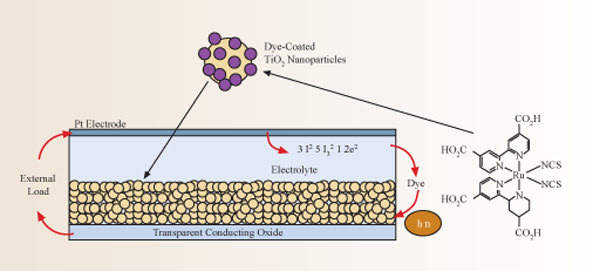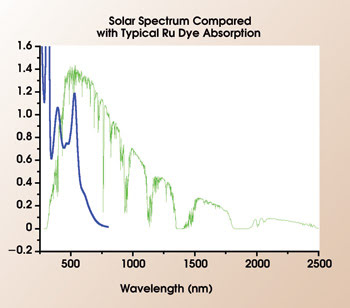Dye-sensitized solar cells offer the possibility of low-cost photovoltaics with low-energy manufacturing.
Neil Robertson, University of Edinburgh
In recent decades, the photovoltaic market has experienced tremendous growth — about 20 to 25 percent per year. The growth occurred because of the pressing need to establish renewable energy around the world and because photovoltaic technology was supported politically in countries such as Japan and Germany. In such a rapidly expanding market, there is an opportunity for various approaches to solar energy — whether it be crystalline silicon (c-Si), amorphous silicon, thin-film cells or high-efficiency cells for solar concentrator systems — that may find use in bulk or niche areas.
The interest in solar energy has grown because of widespread recognition that it is probably the only renewable source that can fulfill our long-term energy needs, which are estimated to rise from 12.7 TW in 1998 to 46 to 59 TW by 2100. One hour of solar radiation incident on the Earth currently is sufficient to supply its entire annual needs; however, the challenge in using this radiation lies in its low energy density and in the requirement for very low cost devices for the energy conversion. The high cost associated with the current commercial products, although falling, still is a barrier to mass uptake of photovoltaic technology.
In this environment, low-cost photovoltaics could be a significant advancement that would have a profound effect on the planet. Dye-sensitized solar cells have emerged over the past 15 years as a technology that might provide low-cost, efficient and stable photovoltaics. The basic function of such devices differs from that of p-n junction solar cells; it is closer in similarity to color photography based on dye-sensitized semiconductor particles (Figure 1).

Figure 1. A dye molecule absorbs solar radiation, and the resulting excited-state electron is transferred to an interconnected network of TiO2 nanoparticles on which the dye molecules are anchored. The dye is regenerated by electron transfer from a solution or a solid-state electrolyte that interpenetrates the nanoparticles. Thus, the electron and the hole have been separated and migrate to a transparent electrode and Pt electrode, respectively. The resulting electron flow is shown by red arrows.
Dye-sensitized solar cells first were developed by professor Michael Grätzel of École Polytechnique Fédérale in Lausanne, Switzerland; by the mid-1990s, his group had demonstrated cells with power-conversion efficiency of about 11 percent. Although this efficiency was lower than that of c-Si solar cells, the investigators obtained it using only low-cost semiconductor and other materials, although they also used a solution-based electrolyte and volatile solvents, which are not appropriate for easily manufactured and long-term stable devices. In addition, the dyes that performed best in these cells were based on complexes of the expensive metal ruthenium; although only a monolayer of dye is required, some have questioned whether dyes not dependent on an expensive metal might ultimately be required.
In the past 15 years, studies with dye-sensitized semiconductor particles have tried to replace the solution electrolyte with a gel electrolyte, an ionic liquid electrolyte, a solid hole conductor or other nonvolatile conducting materials. However, the lower charge mobility in such alternatives leads to lower device efficiencies, and thus investigators have attempted to design dyes that compensate for this; for example, by using higher-absorbing ones for thinner devices with less charge-recombination losses.
Other work not only has tailored the technology for substrates such as metal films or plastics but also has achieved a greater understanding of the key material functions; has designed new, efficient dyes that don’t depend on ruthenium; and has developed dyes that give higher long-term stability to hydrolysis from the TiO2 surface. Improved efficiency also remains an important target. The best current dyes can harvest radiation out to only ∼700 nm, leaving much room for enhanced devices if panchromatic dyes or cosensitization with several dyes can be made more effective (Figure 2).

Figure 2. The solar spectral irradiance (green line) is compared with the absorption spectrum of a typical ruthenium dye (blue line). The units on the Y-axis are Wm–2nm–1 for the solar spectral irradiance and are arbitrary units for the dye.
These varied investigations have led to some commercial manufacturing of dye-sensitized semiconductor particles with sufficient stability and efficiency for use in the consumer goods market. Last year, G24 Innovations Ltd. of Cardiff, UK, began manufacturing dye-sensitized solar cells with initial applications in chargers for devices such as mobile phones; their advantages include low-cost and low-energy roll-to-roll manufacturing.
Will dye-sensitized solar cells make the gradual transition from such niche markets to those generating mass power, such as building-integrated photovoltaics? This depends on many factors, including improvements in long-term stability, manufacturability and efficiency. The strong general growth in photovoltaics may provide the push that scientists and business visionaries need to take dye-sensitized semiconductor solar cells to the next level.
Acknowledgment
The author would like to acknowledge the Engineering and Physical Sciences Research Council Supergen Excitonic Solar Cells Consortium for its support in this research.
Meet the author
Neil Robertson is a senior lecturer in inorganic and materials chemistry at the University of Edinburgh, UK; e-mail: [email protected].